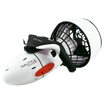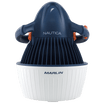FAQ
Below you'll find answers to the questions we get asked the most about seascooters.
Can I travel on an airplane with a Seascooter?
Passengers can carry most consumer-type batteries and portable battery-powered electronic devices for their own personal use in carry-on baggage.
Lithium Ion: With airline approval, devices can contain larger lithium-ion batteries (101–160 watt hours per battery), but spares of this size are limited to two batteries in carry-on baggage only. To determine watt hours (Wh), multiply the volts (V) by the ampere hours (Ah). Example: A 12-volt battery rated to 8 Amp hours is rated at 96-watt hours (12 x 8 = 96).
Lead Acid: Often referred to as gel cells and non-spillable wet batteries. These batteries are allowed in carry-on baggage limited to 12 volts and 100-watthours per battery. Passengers are also limited to two (2) uninstalled batteries.
What is the difference between Lead Acid Battery and Lithium-Ion Battery?
There are a variety of differences between these two batteries however in the simplest terms:
Lithium-ion batteries are one-third (or less) the weight of lead acid batteries.
Lithium-ion batteries charge faster than lead acid batteries.
Lithium-ion batteries have a longer life span, they cycle 5000 times or more compared to just 400-500 cycles in lead acid. Cycle life is greatly affected by higher levels of discharge in lead acid, versus only slightly affected in lithium-ion batteries.
Voltage: Lithium-ion batteries maintain their voltage throughout the entire discharge cycle. This allows for greater and longer-lasting efficiency of electrical components. Lead acid voltage drops consistently throughout the discharge cycle.
Lithium-ion batteries are more expensive.
Lithium-ion batteries require less maintenance.
Lithium-ion batteries are a much cleaner technology and are safer for the environment.
What should I do if my Seascooter needs maintenance?
We have two service centers in the USA
If located on the East Coast call Tel: 863-248-1110 | 888-506-3281, or email: Seascooter@atlantic.net
If located on the West Coast call 1(800) 361-2781 or Email: support@nauticaseascooters.com
What does WH (watt hours) mean?
To determine watt hours (Wh), multiply the volts (V) by the ampere hours (Ah). Example: A 12-volt battery rated to 8 Amp hours is rated at 96-watt hours (12 x 8 = 96). For milliamp hours (mAh), divide by 1000 (to get to Ah) and then multiply by the volts.
Can I use my Seascooter in fresh water and salt water?
These Seascooters are designed for use in seawater. It will have less buoyancy in fresh water, lake or pool and may sink in such waters.
What is included with the Seascooters?
All Seascooters come with a battery and charger. Some come with additional accessories, refer to the product page for details.
Does the Seascooter float?
Some models are neutral buoyant, which means they will not float to the top or sink. Some are positive buoyant, which means they will float to the surface. Keep in mind Nautica Seascooters are designed for use in seawater. It will have less buoyancy in fresh water, lake or pool and may sink in such waters.
Are additional batteries available for purchase?
Lead acid batteries are available for purchase on http://www.seascooterexpress.com while lithium-ion batteries will be available for purchase on our website soon.
What is the depth rating on the Seascooter?
Each model has a different depth rating. Refer to the product pages or user manuals for details.
Where can I buy replacement parts such as chargers and batteries?
Spare parts are available on our Batteries Page or http://www.seascooterexpress.com
What kind of camera can I use on the mount?
The mount holds many of the standard action cameras.

















